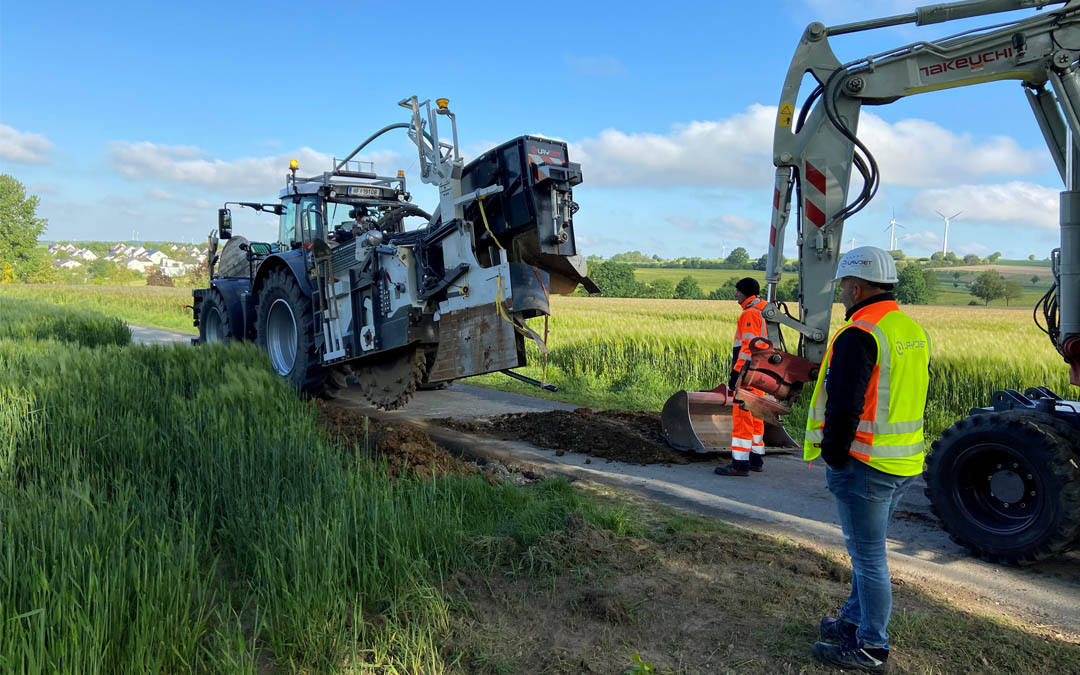DIN 18220 comes into force on July 28. The full name of the standard is “DIN 18220:2023-08. Trenching, milling and ploughing methods for laying empty conduit infrastructures and fiber optic cables for telecommunications networks” and describes in detail the methods for trenches and cable trenches for fiber optic expansion at different depths, for laying the fiber optic media and for restoring the road.
The importance of this standardization is also demonstrated by the ceremonial handover of the document as part of an event on the gigabit strategy of the Federal Ministry for Digital and Transport (BMDV). The Executive Board of the German Institute for Standardization (DIN), which is responsible for DIN standards in Germany, handed over a copy of DIN 18220 to BMDV State Secretary Stefan Schnorr at the beginning of July. The industry, local authorities and companies involved in the expansion have been waiting for some time for the standardized specifications on alternative installation methods for fibre optic expansion, which promise greater safety during expansion.
“With DIN 18220, fiber optic expansion will not only be easier in the future, but also of higher quality, faster, more cost-effective and more resource-efficient. DIN 18220 creates the necessary legal certainty and investment security for all parties involved,” said State Secretary Stefan Schnorr, describing the importance of the new standard.
More than 30 experts from the construction industry, telecommunications industry, science and public administration have worked on DIN 18220 and have now finally defined detailed specifications and uniform quality requirements for construction methods for the installation of fiber optic networks. It was drawn up by consensus and adopted unanimously following a public consultation process. It is therefore a recognized technical rule in accordance with Section 126 of the German Telecommunications Act and must be applied uniformly by all parties involved from the time of its publication.
With alternative installation methods such as trenching, milling and ploughing – in contrast to traditional civil engineering – slots are created for empty conduits and fiber optic cables. Well coordinated between the companies involved and the administration, this can ensure that the expansion is carried out quickly and gently for roads and traffic. Until now, there have been no technical rules for their application, which has made many local authorities reluctant to use these methods. Modern laying techniques and their standardization can now accelerate the expansion of fibre optics.
Guidelines for planning, construction and documentation
DIN 18220 describes the various methods for laying fiber optic cables underground. Specifically, these are trenching, milling and ploughing methods for microducts, microduct composites, cable protection conduits and underground telecommunication cables. It also defines the conditions for planning and documentation and describes project execution. It provides clear and reliable specifications for the construction of trenches of different widths and depths, the laying of the telecommunications infrastructure, as well as the backfilling and restoration of the expansion route. The clear specifications for as-built surveys, construction planning and execution as well as the consideration of existing line infrastructures also support the preparation of complete applications and promote a speedy approval process by the authorities. It does not consider above-ground installation methods or installation in wastewater pipes.
Many of the minimally invasive methods described in DIN18220 have already been in use for more than ten years. However, the standard can now help to increase their acceptance in local authorities. This is because laying fiber optic cables using these methods is cheaper and up to five times faster than traditional civil engineering. This also means less impact on the environment and local residents.
Relevant links:
https://aconium.eu/din-entwurf-fuer-alternative-verlegetechnik-veroeffentlicht/
https://aconium.eu/klassische-und-alternative-verlegemethoden/

